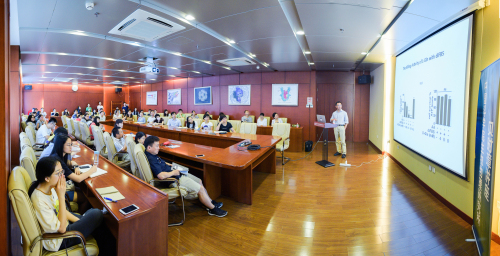Prof. Xuejun Jiang from Cornell University Weill Medical College and Gerstner Sloan-Kettering Graduate School Visited IBP and Delivered the Shizhang Bei Lecture
On September 7, 2017, Prof. Xuejun Jiang visited Institute of Biophysics, CAS and gave a lecture entitled “To be or not to be, a dilemma of cellular metabolism and autophagy”. The lecture was hosted by Prof. Hong Zhang, and was part of the special lecture series named “Shizhang Bei Lecture” of Institute of Biophysics.
In multicellular organisms, programmed cell death, particularly apoptosis, is frequently activated in a highly orchestrated manner to fulfill specific physiological functions. Apoptosis is not the only mechanism for programmed cell death. Recently, another form of regulated necrosis, known as ferroptosis, has been identified. It was shown that a synthetic compound, erastin, can induce a form of non-apoptotic cell death that requires iron. However, the mechanisms of ferroptosis are not well defined.
In the presentation, Prof. Sheng reports the discovery of multiple molecular components of ferroptosis and its intimate interplay with cellular metabolism and redox machinery. Nutrient starvation often leads to sporadic apoptosis. Strikingly, they found that upon deprivation of amino acids, a more rapid and potent necrosis process can be induced in a serum-dependent manner, which was subsequently determined to be ferroptosis. Two serum factors, the iron-carrier protein transferrin and amino acid glutamine, were identified as the inducers of ferroptosis. They further found that the cell surface transferrin receptor and the glutamine-fueled intracellular metabolic pathway, glutaminolysis, played crucial roles in the death process. Inhibition of glutaminolysis, the essential component of ferroptosis, can reduce heart injury triggered by ischemia-reperfusion, suggesting a potential therapeutic approach for treating related diseases.
Prof. Jiang summarized that they presented evidence to support that glutaminolysis was a potential therapeutic target for treating heart injury caused by ischemia-reperfusion, likely due to the essential role of glutaminolysis in ferropotosis.
Prof. Xuejun Jiang gave the lecture with vivid words, rigorous logic and great passion, which can be a lively lesson for the audience. Many investigators from Institute of Biophysics attended the lecture. After the lecture, Prof. Xuejun Jiang and the audience shared their views on the issues of common interest.



